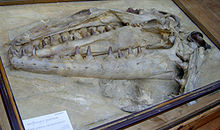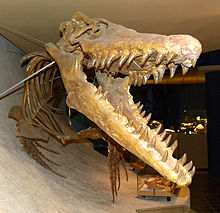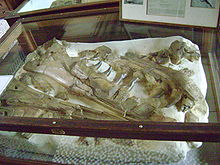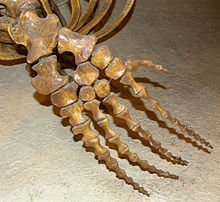- Mosasaurus
-
Mosasaurus
Temporal range: Late Cretaceous, 70–65.5 MaMounted skeleton of M. hoffmannii, Maastricht, Netherlands Scientific classification 
Kingdom: Animalia Phylum: Chordata Class: Reptilia Order: Squamata Family: †Mosasauridae Tribe: †Mosasaurini Genus: †Mosasaurus
Conybeare, 1822Type species †Mosasaurus hoffmannii
Mantell, 1829Species †M. hoffmannii Mantell, 1829
†M. missouriensis (Harlan, 1834)
†M. conodon Cope, 1881
†M. lemonnieri Dollo, 1889
†M. beaugei Armbourg, 1952Synonyms Drepanodon Leidy, 1861
Lesticodus Leidy, 1861
Baseodon Leidy, 1865
Capelliniosuchus
Nectoportheus Cope, 1868
Pterycollosaurus Dollo, 1882
Amphekepubis Mehl, 1930
Batrachiosaurus Harlan, 1839
Batrachotherium Harlan, 1839Mosasaurus (
 /ˌmoʊzəˈsɔrəs/; "lizard of the Meuse River") is a genus of mosasaur, carnivorous, aquatic lizards, somewhat resembling flippered crocodiles, with elongated heavy jaws. The genus existed during the Maastrichtian age of the Cretaceous period (Mesozoic era), around 70-65 millions years ago in the area of modern Western Europe and North America. The name means "Meuse lizard", as the first specimen was found near the Meuse River (Latin Mosa + Greek sauros lizard). The genus Capelliniosuchus, once thought to be a metriorhynchid crocodylian, is a junior synonym of Mosasaurus.
/ˌmoʊzəˈsɔrəs/; "lizard of the Meuse River") is a genus of mosasaur, carnivorous, aquatic lizards, somewhat resembling flippered crocodiles, with elongated heavy jaws. The genus existed during the Maastrichtian age of the Cretaceous period (Mesozoic era), around 70-65 millions years ago in the area of modern Western Europe and North America. The name means "Meuse lizard", as the first specimen was found near the Meuse River (Latin Mosa + Greek sauros lizard). The genus Capelliniosuchus, once thought to be a metriorhynchid crocodylian, is a junior synonym of Mosasaurus.Contents
Description
As with most mosasaurs, their legs and feet are modified into hydrofoil-like flippers, with the forelimbs larger than the hindlimbs. Like its American relatives Tylosaurus and Hainosaurus, Mosasaurus reached lengths of about 15 meters. However, Mosasaurus was more robust than the similarly sized tylosaurine mosasaurs.
Mosasaurus was among the last mosasaur genera, and among the largest. The skull was more robustly built than other mosasaurs, as the mandibles articulated very tightly with the skull. It had a deep, barrel-shaped body, and with its fairly large eyes, poor binocular vision, and poorly developed olfactory bulbs, experts believe that Mosasaurus lived near the ocean surface, where it preyed on fish, turtles, ammonites, and possibly smaller mosasaurs. The animal remained near the surface and although it was able to dive, it evidentially did not venture into deeper waters.
The skull of Mosasaurus tapered off into a short, conical process, and the jaws were armed with massive, sharp, conical teeth. Their paddle-like limbs had five digits in front and four in back. The trunk terminated in a strong tail which, together with serpentine undulation of the whole body, contributed far more to the animal's locomotion than did the limbs.
History of discovery
First discoveries
Mosasaurus was the first genus of mosasaur (and in fact, the first genus of prehistoric reptile) to be named.[1] The first remains known to science were a fragmentary skull from a chalk quarry in the St Pietersberg, a hill near Maastricht, Netherlands, found in 1764 and collected by lieutenant Jean Baptiste Drouin in 1766. It was described in 1790 by Martinus van Marum, the first director of the Teylers Museum at Haarlem, who considered it to be a fish.[2] The same year van Marum procured the fossil for the museum; it is still part of the collection as TM 7424.[3]
At some time between 1770 and 1774 (the often mentioned date of 1780 is incorrect) a second partial skull was discovered and procured by canon Theodorus Joannes Godding, who displayed it in his country house on the slope of the hill. A local retired German/Dutch army physician, Johann Leonard Hoffmann, also collected some fragments and published about the skull; his correspondence with international scientists made the find world famous. Hoffmann presumed the animal was a crocodile. In 1786 however, the Dutch Professor Petrus Camper disagreed and concluded the remains were those of an "unknown sperm whale", of a "Physeteris incognitis ex Monte S. Petri".[4]
In 1794 Maastricht, an important fortress city, was captured by the French revolutionary armies. Accompanying the French troops was geologist Barthélemy Faujas de Saint-Fond on a mission to secure the piece, together with représentant du peuple (political commissar) Freicine who during the campaign tried to transport anything of artistic or scientific value he could lay his hands on to France. Finding that it had been removed from the cottage and hidden within the fortress, Freicine offered "six hundred bottles of good wine" to those troops being the first to locate the skull; soon a dozen grenadiers claimed their reward, carrying the piece with them. Early 1795 it was moved to Paris as war booty, by decree declared a national heritage and added to the collection of the new Muséum national d'Histoire naturelle.
In 1799 Faujas de Saint-Fond published his Histoire naturelle de la montagne de Saint-Pierre de Maestricht [Tome 2], which also contained an account of the circumstances of the find. According to him Dr Hoffmann paid the quarrymen extra to look out for especially large specimens. When the skull was found in 1770 Hoffmann would have been present during the excavation. Afterwards Godding would have claimed his rights as landowner and forced Hoffmann to relinquish his ownership through a lawsuit, won by influencing the court. De Saint-Fond nevertheless, in 1795, saved the specimen for science, paying a considerable indemnity to Godding to compensate for his loss. However, as Dutch historian Peggy Rompen showed, of this famous story very little can be substantiated by other sources. Godding was the original owner, Hoffmann clearly never possessed the fossil, there was no lawsuit, de Saint-Fond probably never paid anything and the entire account seems to have been fabricated by him to justify the dispossession by military force.[5]
Identification as an extinct reptile
 M. hoffmannii holotype jaw fragments ("great animal from Maastricht" specimen), Muséum national d'histoire naturelle, Paris
M. hoffmannii holotype jaw fragments ("great animal from Maastricht" specimen), Muséum national d'histoire naturelle, Paris
De Saint-Fond still assumed the specimen represented a crocodile. In 1798 the son of Petrus Camper, Adriaan Gilles Camper, again studied the fossil indirectly by reconsidering the description by his father. He was the first to reach the conclusion that the remains were those of a giant monitor, which result in 1799 he corresponded to Georges Cuvier.[6]
In 1808 Cuvier confirmed Camper's result. The fossil had already become part of Cuvier's first speculations on the possibility of animal species going extinct. The idea of extinction paved the way for his theory of catastrophism or "consecutive creations", one of the predecessors of the evolution theory. Prior to this, almost all fossil reptile specimens, when recognized as having come from one-living animals, were interpreted as forms similar to those of the modern day: crocodiles, fish, whales, or large land mammals. Cuvier's idea that the Maastricht specimen was a gigantic version of a modern animal unlike any species alive today seemed strange, even to him. He justified this by trusting his techniques in the then-developing field of comparative anatomy, which he had already used to identify giant, extinct members of other modern groups known only from fossils, including giant tapir and ground sloth specimens.[1]
A scientific name had not yet been given to the new species, the specimen usually being referred to as the Grand Animal fossile des Carrières de Maëstricht or "Great Fossil Animal of the Maastricht quarries". In 1822 William Daniel Conybeare named it Mosasaurus after the Latin name (Mosa) of the Maas (Meuse) River passing along Mount Saint Peter, the second skull being the holotype, MNHNP AC9648. The specific name (epithet) hoffmannii was added by G.A. Mantell in 1829, honouring Hoffmann, on the presumption he was the discoverer of the type specimen. The emendated form hoffmanni often used today, is contrary to the rules of the ICZN that state "the original spelling of a name [...] is to be preserved."[7]
In 1854 German biologist Hermann Schlegel was the first to conjecture Mosasaurus had flippers instead of normal feet.
In 1998, another, even bigger and more intact fossil skull was found in the Maastricht limestone quarries, nicknamed "Bèr", and displayed in the Maastricht Natural History Museum. However, it was determined this find represented a new species of the genus Prognathodon.
Classification and species
The family Mosasauridae is split into several subfamilies, with Mosasaurus being placed within Mosasaurinae. This subfamily, in turn, is further split into smaller tribes, with Mosasaurus being grouped with Clidastes, Moanasaurus, Amphekepubis, and Liodon in the tribe Mosasaurini.
Since the genus was first named in the early 19th Century, numerous species have been assigned to Mosasaurus. However, only four are currently recognized as valid by most researchers: M. hoffmannii Mantell 1829 (the type species), M. lemonnieri Dollo 1889, M. missouriensis (Harlan 1834), and M. beaugei Armbourg, 1952.[8]
Other named, but invalid or dubious species include:
M. copeanus Marsh, 1869
M. crassidens Marsh, 1870
M. dekayi Bronn, 1838
M. giganteus (Somering, 1916)
M. gracilis Owen, 1851
M. hardenponti
M. hobetsuensis Suzuki, 1985
M. johnsoni (Mehl, 1930)
M. lonzeensis Dollo, 1904
M. lundgreni (Schroder, 1885)
M. meirsii Marsh, 1869
M. mokoroa Welles & Gregg, 1971
M. neovidii von Meyer, 1845
M. prismaticus Sakuai, Chitoku & Shibuya, 1999
M. scanicus Schroder, 1885
M. iguanavus (Cope, 1868)
M. poultneyi Martin,1953References
- ^ a b Evans, M. (2010). "The roles played by museums, collections and collectors in the early history of reptile palaeontology." Pp. 5-31 in Moody, R.T.J., Buffetaut, E., Naish, D. and Martill, D.M. (eds.) Dinosaurs and Other Extinct Saurians: A Historical Perspective. Geological Society Special Publication 343.
- ^ van Marum, M. (1790). "Beschrijving der beenderen van den kop van eenen visch,…" Verhandelingen Teylers Tweede Genootschap 9: 383-389
- ^ Mulder, Eric Wolfgang Amadeus. 2004. "Maastricht Cretaceous finds and Dutch pioneers in vertebrate palaeontology". In: Touret, J.L.R. & Visser, R.P.W. (eds). Dutch pioneers of the earth sciences, pp. 165-176. Royal Netherlands Academy of Arts and Sciences (KNAW), Amsterdam
- ^ P. Camper, "Conjectures relative to the petrifactions found in St. Peter’s Mountain near Maestricht", Philosophical Transactions 76: 443-456. Camper applied the genitive case; the nominative would render a Physeter incognis
- ^ P. Rompen, 1995, Mosasaurus hoffmanni: De lotgevallen van een type-exemplaar
- ^ A.G. Camper, 1800, "Lettre de A.G. Camper à G. Cuvier sur les ossemens fossiles de la montagne de St. Pierre, à Maëstricht", Journal de Physique 51 (1800) p. 278-291
- ^ See: ICZN Art. 31.1.3 plus example.
- ^ Lindgren, J. and Jagt, J.W.M. (2005). "Danish mosasaurs." Netherlands Journal of Geosciences — Geologie en Mijnbouw, 84(3): 315-320.
- Bardet, N. and Jagt, J.W.M. 1996. Mosasaurus hoffmanni, le “Grand Animal fossile des Carrières de Maestricht”: deux siècles d’histoire. Bulletin du Muséum national d’Histoire naturelle Paris (4) 18 (C4): 569–593.
- Benes, Josef. Prehistoric Animals and Plants. Pg. 144. Artia, 1979
- Mulder, E.W.A. 1999. Transatlantic latest Cretaceous mosasaurs (Reptilia, Lacertilia) from the Maastrichtian type area and New Jersey. Geologie en Mijnbouw 78: 281–300.
External links
- Mosasauridae Translation and Pronunciation Guide [1]
- Oceans of Kansas [2]
- Natural History Museum of Maastricht in the Netherlands [3]
- Dutch Wikipedia on Mosasaurus nl:Mosasaurus
Mosasaur Halisaurinae Mosasaurinae Amphekepubis · Carinodens · Clidastes · Dallasaurus · Globidens · Liodon · Moanasaurus · Mosasaurus · Plesiotylosaurus · Plotosaurus · PrognathodonPlioplatecarpinae Angolasaurus · Ectenosaurus · Igdamanosaurus · Platecarpus · Plioplatecarpus · Selmasaurus · YaguarasaurusTylosaurinae Undetermined Related articles Related categories Mosasaurs · Cretaceous lizards · Marine reptilesCategories:- Mosasaurs
- Fossil taxa described in 1822
Wikimedia Foundation. 2010.






